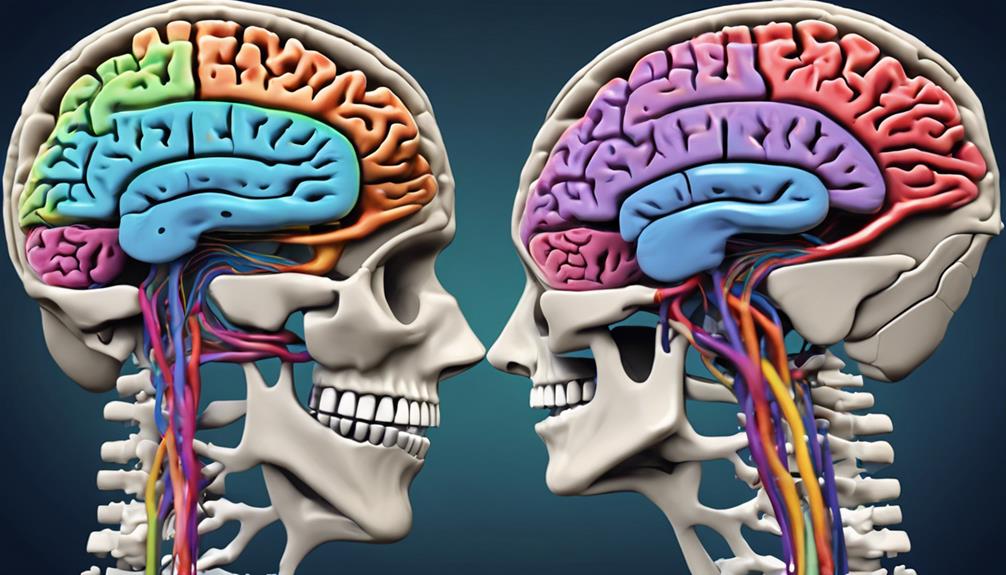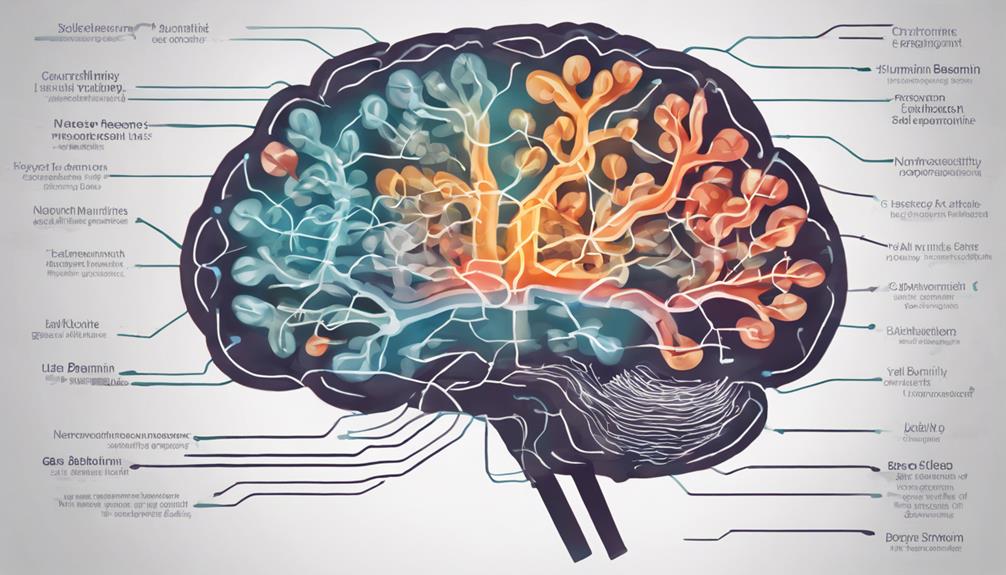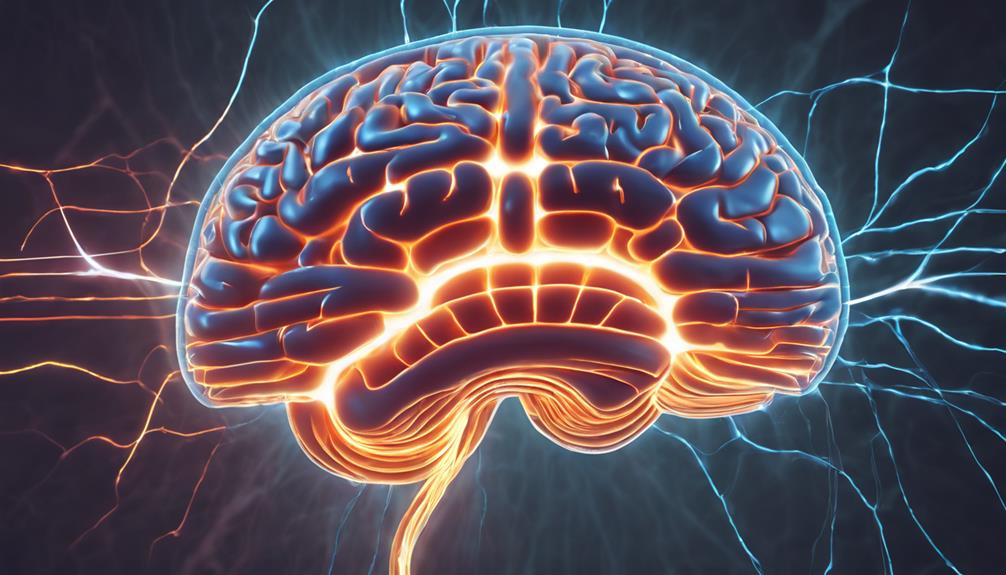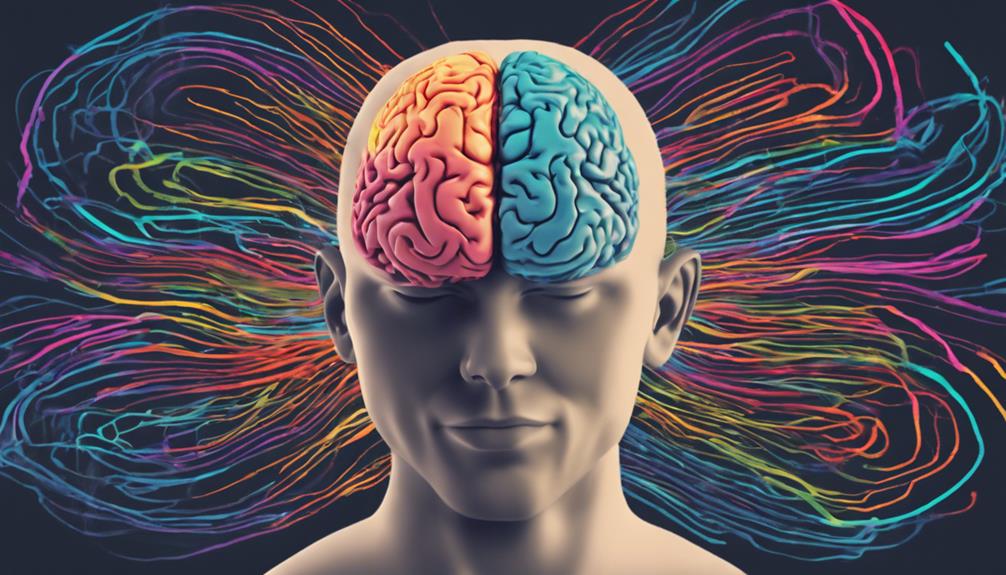Neuroscience uncovers the brainwave patterns and regions involved in hypnosis, revealing altered cognitive processing. The prefrontal cortex, essential for cognitive control, shows decreased activity during hypnosis, impacting perception and behavior. Modulation of neurotransmitters like GABA, serotonin, and dopamine influences hypnotic states, leading to altered consciousness. Changes in the Default Mode Network during hypnosis affect suggestibility and attention, shaping states of consciousness. Specific brain regions process suggestions, with the prefrontal cortex and anterior cingulate cortex playing pivotal roles. Exploring how neural pathways interact in hypnosis offers profound insights into the intricate workings of the mind.
Brain Activity During Hypnosis

Research into brain activity during hypnosis has provided valuable insights into the neural mechanisms underlying this unique psychological state. Studies have shown that individuals in a hypnotic state exhibit distinct brainwave patterns known as hypnotic brainwaves. These brainwaves, characterized by increased theta activity and decreased alpha and beta waves, are associated with heightened suggestibility and focused attention, hallmarks of the hypnotic experience.
Furthermore, neuroimaging studies have revealed changes in brain regions involved in cognitive processing during hypnosis. The dorsolateral prefrontal cortex, responsible for decision-making and cognitive control, shows decreased activity, suggesting a reduced sense of self-awareness and critical judgment during hypnosis.
In contrast, regions such as the anterior cingulate cortex and insula, which play roles in emotion regulation and self-referential processing, exhibit increased connectivity, indicating a shift towards internal focus and suggestibility.
Role of the Prefrontal Cortex
Noteworthy alterations in prefrontal cortex activity during hypnosis shed light on the substantial impact this brain region has on the hypnotic state. The prefrontal cortex, known for its crucial role in cognitive control and executive functions, plays a significant part in modulating attention, decision-making, and self-awareness, all of which are altered during hypnosis.
Research indicates that during hypnosis, there is a decrease in prefrontal cortex activity, particularly in areas associated with self-referential processing and reality monitoring. This reduction in prefrontal cortex activation may explain the characteristic changes in perception and suggestibility observed in individuals under hypnosis.
Moreover, the prefrontal cortex's involvement in cognitive control mechanisms, such as inhibitory control and working memory, is essential for understanding how hypnosis can influence behavior and suggestibility. By altering prefrontal cortex function, hypnosis may temporarily disrupt normal cognitive processes, leading to increased responsiveness to suggestions and alterations in perception.
Neurotransmitters and Hypnotic States

The modulation of neurotransmitter activity plays a significant role in understanding the mechanisms underlying hypnotic states. Neurotransmitter modulation influences altered consciousness experienced during hypnosis. GABA, an inhibitory neurotransmitter, is thought to increase during hypnosis, leading to reduced neural activity in certain brain regions. This reduction in neural activity may contribute to the suggestibility often observed in hypnotic states.
Furthermore, the interplay of neurotransmitters like serotonin and dopamine can influence the depth and quality of hypnotic experiences. Serotonin, known for its role in mood regulation, may impact emotional responses during hypnosis. Dopamine, associated with reward and motivation, could influence the reinforcement of hypnotic suggestions.
Neural pathways involved in hypnotic suggestibility are interconnected with regions responsible for attention, memory, and self-awareness. Understanding how neurotransmitter activity affects these neural pathways provides insights into the complex nature of hypnotic states.
Future research on neurotransmitter modulation and its effects on neural circuits during hypnosis may uncover more about the brain mechanisms underlying this intriguing phenomenon.
Default Mode Network in Hypnosis
The restructuring of neural connectivity within the brain's default mode network is a crucial aspect to consider when examining hypnotic states. The default mode network (DMN) is a set of brain regions that are typically active when an individual is at rest and not focused on the outside world.
During hypnotic induction, there is evidence to suggest that the connectivity within the DMN undergoes changes, leading to alterations in consciousness and perception.
Studies using neuroimaging techniques have shown that during hypnosis, there is a decrease in DMN activity, particularly in regions associated with self-referential thoughts and mind wandering. This reduction in DMN connectivity is thought to be linked to the heightened suggestibility and focused attention experienced during hypnosis.
Furthermore, increased connectivity between certain brain regions involved in attention, perception, and cognitive control has been observed during hypnotic states, suggesting a reorganization of neural networks to facilitate the hypnotic experience.
Understanding the role of the default mode network in hypnosis provides valuable insights into the neural mechanisms underlying hypnotic phenomena and highlights the importance of connectivity changes within the brain in shaping altered states of consciousness.
Neural Correlates of Suggestion

Revisiting neural activity patterns, specifically those related to suggestion, sheds light on the intricate brain processes underlying the phenomena of hypnosis.
Cognitive processes play a central role in how suggestions are received and acted upon during hypnosis.
Studies using neuroimaging techniques, such as functional magnetic resonance imaging (fMRI) and electroencephalography (EEG), have identified neural correlates associated with suggestion responsiveness.
These studies have revealed that certain brain regions, including the prefrontal cortex and anterior cingulate cortex, are involved in processing suggestions and modulating behavior.
Furthermore, neural plasticity, the brain's ability to reorganize itself by forming new neural connections, plays a crucial role in how suggestions are integrated and implemented.
Through repeated exposure to hypnotic suggestions, neural plasticity may facilitate the establishment of new neural pathways that support the adoption of suggested behaviors or beliefs.
Understanding the neural correlates of suggestion and the role of neural plasticity in hypnosis can provide valuable insights into the mechanisms underlying hypnotic phenomena.
Hypnotic Trance and Brain Function
Exploring the neural mechanisms underlying hypnotic trance reveals intricate interactions between brain function and altered states of consciousness.
During hypnotic trance, individuals often experience an altered state of consciousness characterized by heightened suggestibility and focused attention. This altered consciousness can influence cognitive processing, leading to an increased responsiveness to hypnotic suggestions.
Neuroscientific studies have shown that hypnotic suggestions can elicit specific neural responses in the brain, including changes in activity within regions involved in attention, perception, and self-awareness. Functional magnetic resonance imaging (fMRI) studies have demonstrated alterations in brain activity patterns during hypnosis, indicating a shift in neural processing associated with the hypnotic trance state.
Furthermore, research suggests that the neural mechanisms underlying hypnotic trance involve complex interactions between cortical and subcortical brain regions, highlighting the intricate nature of brain function during altered states of consciousness. Understanding these neural correlates of hypnosis can provide valuable insights into the mechanisms by which hypnotic suggestions influence behavior and perception.
Frequently Asked Questions
Can Hypnosis Help With Memory Improvement?
Hypnosis shows potential for cognitive enhancement, including memory improvement. Studies suggest hypnosis can enhance recall by tapping into subconscious processes. Further research is needed to explore the full extent of hypnosis in memory enhancement.
Is There a Genetic Component to Hypnotizability?
Genetic influences play a role in hypnotizability, affecting brain activity patterns. Research suggests certain genes may impact susceptibility to hypnosis. Understanding these genetic components can provide insights into individual differences in responsiveness to hypnotic suggestions.
Can Hypnosis Be Used for Pain Management?
Hypnosis can be effective for pain management by utilizing relaxation techniques to alleviate discomfort. It targets cognitive function, offering relief for chronic conditions. Additionally, it has shown promise in improving mental health outcomes through its therapeutic applications.
Are Certain Personality Traits Linked to Hypnotic Susceptibility?
Trait correlations with hypnotic susceptibility have been explored extensively. Research suggests that openness to experience, absorption, and fantasy proneness are linked to hypnotizability. These traits may be connected to underlying psychological mechanisms influencing hypnotic responsiveness.
How Do Cultural Differences Influence Responses to Hypnosis?
Cultural influences play a significant role in shaping individuals' responses to hypnosis. Variations in beliefs, values, and societal norms can impact hypnotic responsiveness. Understanding these cultural nuances is crucial for tailoring effective hypnosis interventions across diverse populations.
Conclusion
In conclusion, neuroscience provides valuable insights into the underlying mechanisms of hypnosis phenomena by studying brain activity, the role of the prefrontal cortex, neurotransmitters, the default mode network, and neural correlates of suggestion.
Understanding how hypnosis affects the brain can help elucidate the therapeutic potential of hypnosis and its impact on cognitive processes.
Further research in this field may lead to advancements in utilizing hypnosis as a tool for various psychological and medical interventions.


